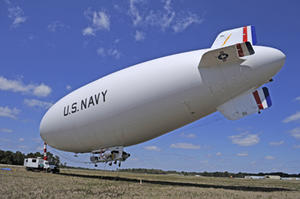BlimpsNavy blimp returns to Maryland, Virginia, and D.C. skies today
The U.S. Navy’s only manned airship, a modified American Blimp Corporation A-170 series commercial blimp, will return to the skies of Maryland today, 12 November, to conduct week-long testing of experimental avionics systems.Results of this research may ultimately help protect forward deployed U.S. Army and U.S. Marine Corps troops around the globe.

The U.S. Navy's MZ-3A airship resumes duty // Source: navy.mil
The U.S. Navy’s only manned airship, a modified American Blimp Corporation A-170 series commercial blimp, will return to the skies of Maryland today, 12 November, to conduct week-long testing of experimental avionics systems.
The Navy MZ-3A will be temporarily based in Frederick, Maryland, and in adherence to standard Federal Aviation Administration (FAA) regulations governing flights within the Washington, D.C., Flight Restriction Zone (DCA-FRZ) the airship is scheduled to fly near Beltsville, Maryland,and to the northeast, near the City of Baltimore.
An NRL release reports that results of this research may ultimately help protect forward deployed U.S. Army and U.S. Marine Corps troops around the globe.
The MZ-3A is government-owned and contractor-operated. The contractor, Integrated Systems Solution Inc. (ISSI) employs highly qualified commercial blimp pilots whom the Navy has approved to command the airship. ISSI airship pilots have completed Special Awareness Training for the Washington, D.C. Metropolitan Area and have experience operating within the airspace.
Loiter times over named regions may vary depending on weather conditions. The mission is scheduled to conclude 25 November, with a return flight to Naval Air Station Patuxent River in St. Mary’s County, Maryland.
Built by American Blimp Corporation, the MZ-3A is propeller-driven by two 180 horsepower Lycoming engines producing a top speed just under 50 knots with an operational payload capability of up to 2,500 pounds. The manned 178-foot lighter-than-air (LTA) “blimp” can remain aloft and nearly stationary for more than twelve hours, performing various missions in support of technology development for Command, Control, Communications, Computers, Intelligence, Surveillance and Reconnaissance (C4ISR) concepts.
